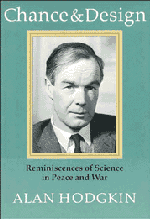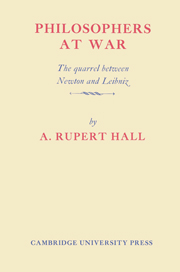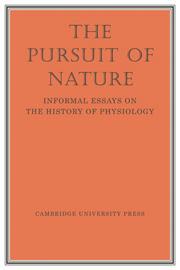Chance and Design
As a student in Cambridge, Alan Hodgkin first became interested in the basis of nerve conduction, using single nerve fibers from a shore crab in his experiments. In 1963, he won the Nobel prize for his work on nerve conduction, and in 1970 became President of the Royal Society.
Chance and Design is a fascinating chronicle of Hodgkin's life, providing a glimpse into the world of Cambridge undergraduates in the thirties, the motivation behind his research into nerve conduction, his work on centimeter radar during World War II, and his life as a Cambridge academic after the war. The book concludes with an account of the Nobel prize ceremony in 1963. This highly readable autobiography gives an insight into the working patterns and private life of an eminent scientist, and will appeal not only to scientists, but also to those interested in gaining an understanding of what inspires scientific research.
Reviews & endorsements
"There is much in this autobiography besides Hodgkin's classic work on neurophysiology. For the physicists, there is a technical account of the development of airborne radar. For the general reader, the book contains vivid descriptions of Hodgkin's happy childhood among the often eccentric members of his many-branched Quaker family and of the Cambridge scene in the 1930s." Nature
"...provides an interesting view of school and family life in Britain between the two world wars, and indeed of life in general at that time....Overall, this was an enjoyable reading experience. Because of its attention to detail and the clear expository style, it is much more than the recounting of an important scientific discovery." Ira S. Cohen, The Quarterly Review of Biology
"There is much in this autobiography besides Hodgkin's classic work on neurophysiology. For the physicists, there is a technical account of the development of airborne radar. For the general reader, the book contains vivid descriptions of Hodgkin's happy childhood among the often eccentric members of his many-branched Quaker family and of the Cambridge scene in the 1930s." M. F. Perutz, Nature
"...provides an interesting view of school and family life in Britain between the two world wars, and indeed of life in general at that time....Overall, this was an enjoyable reading experience. Because of its attention to detail and the clear expository style, it is much more than the recounting of an important scientific discovery." Ira S. Cohen, The Quarterly Review of Biology
"Alan Hodgkin discovered the ionic basis of nerve conduction. In this book, his autobiography, he discloses revealing childhood and family scenes and describes with ardor his undergraduate years at Cambridge, his first trip to America in 1937, and his early experiments with Andrew Huxley in Plymouth....reads like a great novel." Louis J. DeFelice, Biophysical Journal
"...very personal and engaging account of his life." Melvin Wachs, Science Books and Films
"...superbly written and introspective life story..." James R. Hansen, Air Power History
Product details
January 1994Paperback
9780521456036
428 pages
237 × 191 × 22 mm
0.73kg
Available
Table of Contents
- Preface
- Part I. Beginning: Part II. Flight Trials and tribulations: Part III. Starting Again: Notes
- Bibliography
- Index.









